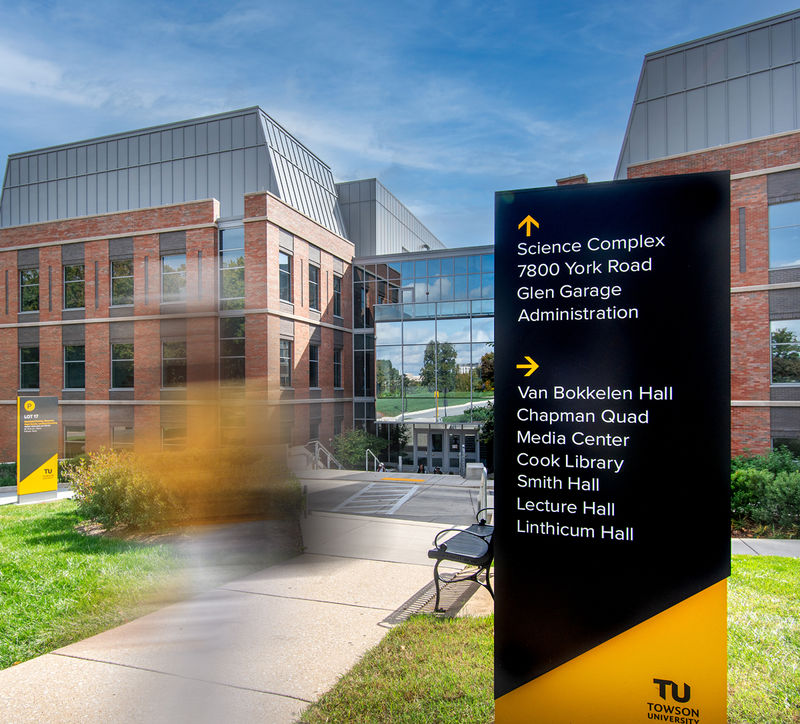
Where campus orientation begins
How to spot and address five frequent ADA signage issues on school campuses.
On a college campus, accessibility plays a defining role in whether students feel supported, empowered, and able to thrive. Still, many universities struggle with the day-to-day realities of ADA implementation. That’s not surprising. As campuses grow – through new construction, renovations, and shifting departmental needs – signage systems can fall out of sync. Room numbers change. Building names evolve. Styles clash. And what was once a clear path becomes a confusing maze. For students, faculty, and visitors with disabilities, these small breakdowns create real barriers – making it harder to navigate, connect, and belong.
With that in mind, here are five challenges to consider around ADA compliance at your school.
KEY CONTRIBUTOR:
Matthew Miller
Lead Planner & Code Compliance Specialist

1. ADA compliance in historic buildings
The challenge: Many older buildings weren’t designed with ADA standards in mind – and they’re protected by historic preservation rules that limit changes. That can make it difficult to install modern signage, especially tactile or high-contrast components.
The solution: Collaborate with preservation boards to develop custom-designed signage that is both ADA-compliant and historically sensitive. Character style, contrast, and placement all contribute to legibility and accessibility – and these can be tailored to complement architectural aesthetics. Materials like cast bronze or wood laminate can reinforce the building’s design legacy while providing accessible, tactile information.
2. Campus navigation for students with disabilities
The challenge: Large campuses with complex layouts can overwhelm visitors – especially students with mobility, visual, or cognitive impairments. Inconsistent signage, poor sightlines, or lack of visual contrast can make it nearly impossible to find classrooms, labs, or support services. Imagine a blind student trying to find the disability services office during the first week of classes – without tactile signs or audio guidance, they may miss out on crucial support.
The solution: A unified wayfinding system designed with accessibility in mind. That includes high-contrast typography, clear hierarchy, and tactile signage with Grade 2 Braille and raised characters. Features like proper character spacing, non-glare finishes, and thoughtful sign placement all play a role in ensuring information is legible and usable for people with low vision.
In addition, digital tools like wayfinding apps with audio instructions or QR-coded signage – can supplement traditional signs without replacing them.

3. Budget constraints and long-term compliance
The challenge: Higher education budgets are always under pressure. While accessibility upgrades are mandatory, funding is often limited – especially for large-scale signage replacement across multiple buildings or campuses.
The solution: Develop a phased signage plan focused on high-traffic areas first – like admissions offices, residence halls, and dining facilities. Sign families and modular systems make it easier to update or expand over time, helping institutions stay compliant without redoing everything at once.
Annual audits and long-range planning can also help identify where the biggest gaps exist – and what improvements will have the highest impact.
4. Keeping up with evolving guidelines
The challenge: ADA standards evolve over time, and each state may have additional accessibility requirements beyond the federal minimum. For example, California and New York both maintain more stringent codes than the baseline ADA standards.
The solution: Partner with experts who monitor regulatory updates and perform regular signage audits. Staying ahead of changes prevents costly retrofits and helps avoid violations. Proactive reviews also create a culture of accessibility – where inclusion is not just a compliance issue, but a core institutional value.
5. Integrating digital and physical wayfinding
The challenge: Many campuses are investing in digital displays, QR codes, and mobile apps to modernize the visitor experience. But if these tools aren’t accessible, they can unintentionally exclude users, especially people with low vision or cognitive impairments.
The solution: Design physical and digital wayfinding to work together. Use tactile signs to provide basic, always-available information. Support that with accessible digital content that follows WCAG (Web Content Accessibility Guidelines) for contrast, readability, and compatibility with screen readers. Digital solutions aren’t a substitute for the tactile signs required by the ADA – they’re meant to complement and enhance them.

From compliance to community
Every sign on campus does more than direct – it communicates who belongs. For students living with disabilities, wayfinding isn’t just a functional need; it’s part of feeling safe, confident, and supported in their daily routines.
The stakes are personal: Will a blind student find the counseling center without help? Can a first-year student in a wheelchair make it to their lecture hall on time? Does a parent with low vision feel welcome on move-in day?
When signage is thoughtfully designed and ADA-compliant, the entire campus becomes more usable and inclusive. And when accessibility is embedded into the built environment – not treated as an afterthought – it reflects an institution’s commitment to equity, care, and belonging.
Thoughtful signage strategy gives institutions a practical way to extend their values into every hallway, classroom, and quad.
Design for lasting impact
Accessibility shapes how students and visitors experience your campus – whether they’re navigating it for the first time or returning daily. For colleges and universities, signage plays a critical role in supporting equity, safety, and a sense of belonging. A thoughtful, consistent approach to ADA-compliant wayfinding reflects your institution’s values and its commitment to serving every member of the community with clarity and care.

Get the details
Our Work in Education



